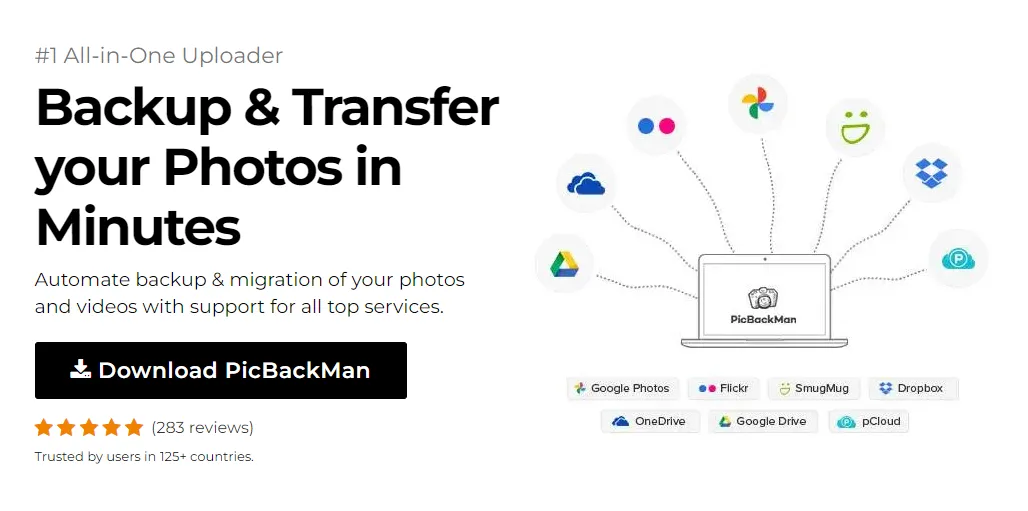Why is it the #1 bulk uploader?
- Insanely fast!
- Maintains folder structure.
- 100% automated upload.
- Supports RAW files.
- Privacy default.
How can you get started?
Download PicBackMan and start free, then upgrade to annual or lifetime plan as per your needs. Join 100,000+ users who trust PicBackMan for keeping their precious memories safe in multiple online accounts.
“Your pictures are scattered. PicBackMan helps you bring order to your digital memories.”
How to AirDrop photos from your Mac using the drag and drop?

Sharing photos from your Mac to other Apple devices should be quick and simple. AirDrop offers exactly that - a fast, wireless way to transfer photos without emails, messages, or third-party apps. In this guide, I'll walk you through the straightforward process of using drag and drop to AirDrop photos from your Mac to your iPhone, iPad, or another Mac.
What You'll Need Before Starting
- A Mac running macOS X Yosemite or later
- A receiving Apple device (iPhone, iPad, or another Mac)
- Both devices must have Wi-Fi and Bluetooth turned on
- Both devices should be within 30 feet of each other
- The photos you want to share
Step-by-Step Guide to AirDrop Photos Using Drag and Drop
Step 1: Make Sure AirDrop is Enabled on Both Devices
Before you start transferring photos, check that AirDrop is properly set up on both your Mac and the receiving device.
On Your Mac:
- Open Finder from your dock or by clicking on your desktop and pressing Command+N
- In the sidebar, click on "AirDrop"
- If Bluetooth or Wi-Fi is turned off, you'll be prompted to turn them on
- At the bottom of the AirDrop window, click on "Allow me to be discovered by" and select either "Contacts Only" or "Everyone"
On Your iPhone or iPad:
- Swipe down from the top-right corner to open Control Center
- Press and hold the network settings card (with airplane mode, cellular data, Wi-Fi, and Bluetooth icons)
- Tap on "AirDrop"
- Choose either "Contacts Only" or "Everyone"
On Another Mac:
- Follow the same steps as for your sending Mac
- Make sure the AirDrop window stays open to receive files
Step 2: Locate the Photos You Want to Share
Now that AirDrop is ready to go, find the photos you want to transfer:
- Open Finder on your Mac
- Navigate to the folder where your photos are stored
- You can use Photos app, Pictures folder, or any location where your images are saved
- If using Photos app, select the photos you want to share
Step 3: Select Your Photos
You can select one or multiple photos to share at once:
- To select a single photo: Simply click on it once
- To select multiple consecutive photos: Click on the first photo, hold down the Shift key, then click on the last photo
- To select multiple non-consecutive photos: Hold down the Command key while clicking on each photo you want to select
Step 4: Begin the Drag and Drop Process
Now comes the actual drag and drop part:
- Click and hold on your selected photo(s)
- Start dragging the photos (your cursor will change to show you're dragging files)
- While still holding the mouse button or trackpad, use your other hand to press and hold the Space bar on your keyboard
- This opens Quick Look, which helps you see what you're dragging
- Continue holding the mouse button/trackpad while you navigate
Step 5: Drag to the AirDrop Section
With your photos "in hand," it's time to find the AirDrop destination:
- While still dragging your photos, move your cursor to the Finder sidebar
- Hover over "AirDrop" in the sidebar
- The Finder window should switch to show available AirDrop recipients
- You'll see icons representing nearby Apple devices that have AirDrop enabled
Step 6: Drop the Photos onto the Recipient
- Drag your selected photos directly onto the icon of the device you want to send them to
- Release the mouse button or trackpad to "drop" the photos
- Your Mac will begin sending the photos to the selected device
Step 7: Confirm the Transfer on the Receiving Device
The recipient will need to accept the incoming photos:
On iPhone or iPad:
- A notification will appear asking to "Accept" or "Decline" the photos
- After tapping "Accept," the photos will be saved to the Photos app
On Mac:
- A notification will appear asking to "Accept" or "Decline"
- After accepting, you can choose where to save the photos
- By default, they'll be saved to the Downloads folder
Alternative Method: Using Finder's AirDrop Window
If you prefer not to use drag and drop, here's another way to AirDrop photos:
- Open Finder and navigate to your photos
- Select the photos you want to share
- Right-click (or Control-click) on the selected photos
- Choose "Share" from the context menu
- Select "AirDrop" from the share options
- A window will appear showing available AirDrop recipients
- Click on the recipient you want to send the photos to
Troubleshooting Common AirDrop Issues
If you're having trouble with AirDrop, try these fixes:
Devices Not Showing Up
| Problem | Solution |
|---|---|
| Devices too far apart | Move devices closer together (within 30 feet) |
| Bluetooth or Wi-Fi issues | Turn both off and on again on both devices |
| AirDrop visibility settings | Make sure both devices are set to be discoverable by "Everyone" or "Contacts Only" (if you're in each other's contacts) |
| Firewall blocking connection | Check your Mac's firewall settings in System Preferences > Security & Privacy > Firewall |
Transfer Starting but Not Completing
- Check that the receiving device has enough storage space
- Try restarting both devices
- Make sure both devices are running compatible operating systems
- Try sending fewer photos at once
Tips for Efficient Photo Sharing via AirDrop
Organizing Photos Before Sharing
To make your AirDrop experience smoother:
- Create a dedicated folder for photos you plan to share
- Use Albums in Photos app to group related images
- Consider batch editing photos before sharing them
Managing Large Photo Transfers
When sending many photos at once:
- Break up very large transfers into smaller batches
- Keep devices plugged in if transferring hundreds of photos
- Stay within close range during large transfers
- Be patient with high-resolution images, as they take longer to transfer
AirDrop vs. Other Sharing Methods
Here's how AirDrop compares to other ways of sharing photos:
| Method | Pros | Cons |
|---|---|---|
| AirDrop | Fast, wireless, maintains full photo quality, no internet needed | Only works between Apple devices, requires devices to be nearby |
| Works across all platforms, no proximity needed | File size limits, may compress photos, requires internet | |
| Cloud Services | Can share large collections, works across platforms | Requires internet, may use up cloud storage quota, extra steps |
| USB Transfer | Very fast for large collections, reliable | Requires physical cable, extra hardware, not wireless |
Quick Tip to ensure your videos never go missing
Videos are precious memories and all of us never want to lose them to hard disk crashes or missing drives. PicBackMan is the easiest and simplest way to keep your videos safely backed up in one or more online accounts.
Simply download PicBackMan (it's free!), register your account, connect to your online store and tell PicBackMan where your videos are - PicBackMan does the rest, automatically. It bulk uploads all videos and keeps looking for new ones and uploads those too. You don't have to ever touch it.
Advanced AirDrop Features
Customizing AirDrop Settings
You can adjust how AirDrop works on your Mac:
- Open Finder and click on "AirDrop" in the sidebar
- At the bottom of the window, click on "Allow me to be discovered by:"
- Choose from these options:
- No One: Turns off AirDrop completely
- Contacts Only: Only people in your contacts can see your device
- Everyone: All nearby Apple devices can see your device
Using AirDrop with Photos Library
The Photos app offers direct AirDrop integration:
- Open Photos app on your Mac
- Select the photos you want to share
- Click the Share button in the top-right corner
- Select AirDrop from the menu
- Choose your recipient from the AirDrop window that appears
Sending Photos to Multiple Devices
To share photos with several people at once:
- Select your photos as normal
- Drag them to the AirDrop section in Finder
- Once the AirDrop window shows available devices, let go of your mouse/trackpad
- Hold down the Command key and click on each recipient you want to send to
- Click the "Send" button
Security Considerations When Using AirDrop
Privacy Settings
To protect your privacy while using AirDrop:
- Use "Contacts Only" mode in public places to prevent strangers from sending you files
- Switch AirDrop to "No One" when not in use
- Be cautious about what photos you share, especially in public settings
- Remember that nearby devices can see your device name
Preventing Unwanted AirDrop Requests
If you're receiving unwanted AirDrop requests:
- Open Finder and click on "AirDrop" in the sidebar
- Change "Allow me to be discovered by" to "Contacts Only" or "No One"
- On iPhone/iPad, open Control Center, press and hold the network card, tap AirDrop, then select "Receiving Off" or "Contacts Only"
Frequently Asked Questions
1. Can I AirDrop photos from my Mac to an Android device?
No, AirDrop is an Apple-exclusive feature that only works between Apple devices (Macs, iPhones, iPads). To share photos with Android devices, you'll need to use alternatives like email, messaging apps, cloud services, or third-party file sharing apps.
2. Why are my AirDropped photos saving in a different format?
AirDrop generally preserves the original file format of your photos. However, if you're sending from the Photos app with edits, these changes might be applied before transfer. Check your export settings in Photos preferences if you want to maintain the original format.
3. Is there a limit to how many photos I can AirDrop at once?
There's no specific limit to the number of photos you can AirDrop simultaneously, but practical limitations exist. Very large transfers (hundreds of high-resolution photos) might be slower or occasionally time out. For extremely large collections, consider breaking them into smaller batches of 50-100 photos each.
4. Do AirDropped photos lose quality?
No, AirDrop transfers files in their original quality without compression. This is one of the main advantages of AirDrop compared to sending photos via email or some messaging apps, which might compress images to save data.
5. Why can't I see my iPhone in AirDrop even though both devices are turned on?
If your iPhone isn't appearing in your Mac's AirDrop window, check that both Wi-Fi and Bluetooth are enabled on both devices, ensure they're within 30 feet of each other, verify that AirDrop is set to be discoverable (either "Contacts Only" or "Everyone"), and try restarting both devices. Also, make sure your devices are running compatible operating systems.
Conclusion
AirDrop's drag and drop feature makes sharing photos between your Mac and other Apple devices incredibly simple. With just a few clicks, you can transfer high-quality images without cables, emails, or messages. The wireless nature of AirDrop means you can quickly share photos with friends, family, or between your own devices without complicated setup or third-party apps.
Remember that both devices need to have Wi-Fi and Bluetooth enabled, and they should be within close range of each other. If you run into any issues, the troubleshooting tips in this guide should help you resolve them quickly. Whether you're sharing a single vacation photo or transferring your entire photo library to a new device, AirDrop's drag and drop functionality offers a seamless experience that's hard to beat.






